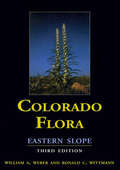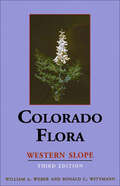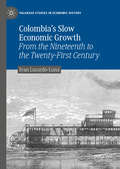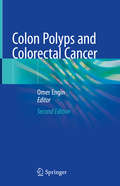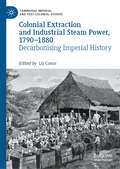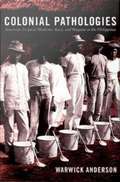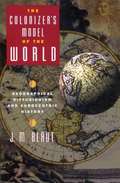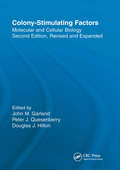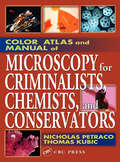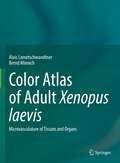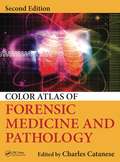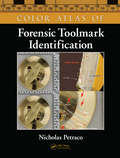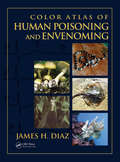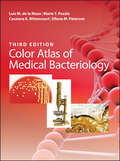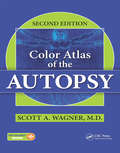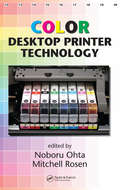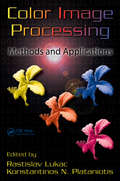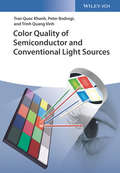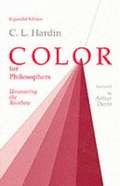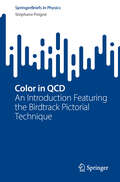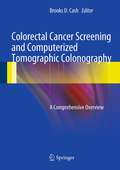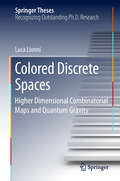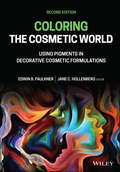- Table View
- List View
Colo Flora: East Slope
by William A. WeberReflecting the conclusions of current taxonomic research and recognizing new species found in the state, these thoroughly updated guides offer the most complete and authoritative reference to the plants of Colorado. Both volumes explain basic terminology; discuss plant geography; and describe special botanical features of the mountain ranges, basins, and plains. Interesting anecdotes and introductions are given for each plant family, and hints on recognizing the largest families are provided as well. Each volume includes a complete glossary, indices to common and specific names, and hundreds of illustrations. Ideal both for the student and scientist, Colorado Flora: Eastern and Western Slopes, Third Edition are essential for readers interested in Colorado's plant life.
Colo Flora: West Slope
by William A. Weber Ronald C. WittmannReflecting the conclusions of current taxonomic research and recognizing new species found in the state, these thoroughly updated guides offer the most complete and authoritative reference to the plants of Colorado. Both volumes explain basic terminology; discuss plant geography; and describe special botanical features of the mountain ranges, basins, and plains. Interesting anecdotes and introductions are given for each plant family, and hints on recognizing the largest families are provided as well. Each volume includes a complete glossary, indices to common and specific names, and hundreds of illustrations. Ideal both for the student and scientist, Colorado Flora: Eastern and Western Slopes, Third Edition are essential for readers interested in Colorado's plant life.
Colombia’s Slow Economic Growth: From the Nineteenth to the Twenty-First Century (Palgrave Studies in Economic History)
by Ivan Luzardo-LunaLooking at the years 1870-2016, this book analyses the reasons behind Colombia’s chronically slow economic growth. As a comparative economic history, it examines why Colombia has seen lower growth rates than countries with similar institutions, culture and colonial origins, such as Argentina in 1870-1914, Mexico in 1930-1980, and Chile from 1982 onwards.While Colombia's history has shown relative macroeconomic stability, it has also shown a limited capacity for integrating into the world economy and embracing technological breakthroughs compared to the rest of the world, including steam, mass production and Information Technology. This volume thus moves away from the long-held view that institutional path dependence is the main determinant of differences in long-run economic growth across countries.
Colon Polyps and Colorectal Cancer
by Omer EnginThis thoroughly revised and extended second edition of the book clearly explains the nature of colon polyps and their relationship to colorectal cancer in light of new developments. It discusses in detail new topics, including polyp development, risk factors and prevention measures, and also describes surgical, medical oncology and radiotherapy treatments of colon cancer. In cases of advanced colon cancer, it clearly demonstrates how to perform surgical interventions in the presence of urinary tract metastases and gynecologic organ metastases. The book also includes chapters on medical treatment and radiotherapy in distant metastases of colorectal cancer. Further, it presents resection of liver metastases and transplantation options. Carefully examining the risk factors, and the treatment of colon cancer from the early to the advanced stages, the book is invaluable not only for medical specialists and students, but also for general readers and patients.
Colonial Extraction and Industrial Steam Power, 1790–1880: Decarbonising Imperial History (Cambridge Imperial and Post-Colonial Studies)
by Liz ConorThis book untangles the connections between British industrialization and colonial expansion in the late-eighteenth and nineteenth centuries. The addition of fossil fuels to the energy mix in this period drove overwhelming social and economic change in Britain, the north-east United States, and Europe, but it also had important and uneven consequences within a range of Euro-American colonies. Opening a new field of inquiry into fossil fuel-powered technologies and their critical role in colonial expansion, this book demonstrates how carbon- based economies dramatically accelerated the annexing of foreign lands and the extraction of their resources. Yet, while the use of coal on a commercial scale from the late 1700s powered an explosion of growth in manufacturing between 1760 and 1840 and these years coincided with the incursion and violence on colonial frontiers, the peripheries tended to rely on wood where they could. This intensification of animal and timber power complicated the nationalist narratives of coal-fired industrialization and economic development. A history of the meanings and ideas around carbon, fossil fuels, and their bearing within colonial expansion is increasingly relevant as rapid changes to climate bring into focus the legacy of carbonization in dispossession, sustainability, environmental, labor, and atmospheric relational histories.
Colonial Pathologies: American Tropical Medicine, Race, and Hygiene in the Philippines
by Warwick AndersonColonial Pathologies is a groundbreaking history of the role of science and medicine in the American colonization of the Philippines from 1898 through the 1930s. Warwick Anderson describes how American colonizers sought to maintain their own health and stamina in a foreign environment while exerting control over and "civilizing" a population of seven million people spread out over seven thousand islands. In the process, he traces a significant transformation in the thinking of colonial doctors and scientists about what was most threatening to the health of white colonists. During the late nineteenth century, they understood the tropical environment as the greatest danger, and they sought to help their fellow colonizers to acclimate. Later, as their attention shifted to the role of microbial pathogens, colonial scientists came to view the Filipino people as a contaminated race, and they launched public health initiatives to reform Filipinos' personal hygiene practices and social conduct. A vivid sense of a colonial culture characterized by an anxious and assertive white masculinity emerges from Anderson's description of American efforts to treat and discipline allegedly errant Filipinos. His narrative encompasses a colonial obsession with native excrement, a leper colony intended to transform those considered most unclean and least socialized, and the hookworm and malaria programs implemented by the Rockefeller Foundation in the 1920s and 1930s. Throughout, Anderson is attentive to the circulation of intertwined ideas about race, science, and medicine. He points to colonial public health in the Philippines as a key influence on the subsequent development of military medicine and industrial hygiene, U. S. urban health services, and racialized development regimes in other parts of the world.
Colonizer's Model of the World
by J. M. BlautThis book challenges one of the most pervasive and powerful beliefs of our time concerning world history and world geography. This is the doctrine of European diffusionism, the belief that the rise of Europe to modernity and world dominance is due to some unique European quality of race, environment, culture, mind, or spirit, and that progress for the rest of the world results from the diffusion of European civilization. J.M. Blaut persuasively argues that this doctrine is not grounded in the facts of history and geography, but in the ideology of colonialism. It is the world model which Europeans constructed to explain, justify, and assist their colonial expansion. The book first defines the Eurocentric diffusionist model of the world as one that invents a permanent world core, an "Inside," in which cultural evolution is natural and continuous, and a permanent periphery, and "Outside," in which cultural evolution is mainly an effect of the diffusion of ideas, commodities, settlers, and political control from the core. The ethnohistory of the doctrine is traced from its 16th-century origins, through its efflorescence in the period of classical colonialism, to its present form in theories of economic development, modernization, and new world order. Blaut demonstrates that most "Western" scholarship is to some extent diffusionist and based implicitly in the idea that the world has one permanent center from which culture-changing ideas tend to emanate. Eurocentric diffusionism has shaped our attitudes concerning race and the environment, psychology and society, technology and politics.
Colony-Stimulating Factors: Molecular & Cellular Biology, Second Edition,
by John M. GarlandConcentrating on proven data and adopting a structure-function approach, this text provides grounding for an intricate understanding of the molecular biology, physiological mechanisms, and routine clinical use in disease settings of colony-stimulating factors (CSFs). This edition includes eight additional chapters, with updates of recently-discovered and established CSFs, each indexed individually.
Color Atlas and Manual of Microscopy for Criminalists, Chemists, and Conservators
by Thomas Kubic Nicholas PetracoProfessionals in many disciplines, from archeology to forensic science and anthropology, must be able to identify organic and inorganic fibers and particles. In a single source, this book presents a range of simple methods to help readers quickly characterize and identify a broad range of materials.
Color Atlas of Adult Xenopus laevis: Microvasculature of Tissues and Organs
by Alois Lametschwandtner Bernd MinnichThis atlas offers stunning color electron scanning micrographs and exceptional light microscopy pictures of capillaries, vessels and diverse histomorphological tissues and organs of Xenopus laevis. The model organisms Xenopus laevis serves to study basic biological questions related to growth, differentiation, maturation, and regression of cells, tissues and organs. Xenopus and human genomes have long stretches of gene collinearity, and 79% of identified human disease genes have a verified ortholog in Xenopus. Thus, this atlas will be a powerful tool for anatomists, morphologists, histologists and physiologists interested in normal and pathologically altered organs and tissue; and to all researchers, who wish to learn more about the microvascular anatomy of this vertebrate model organism.
Color Atlas of Fetal and Neonatal Histology
by Dale S. Huff Eduardo D. Ruchelli Linda M. ErnstColor Atlas of Fetal and Neonatal Histology serves as a comprehensive atlas of the developmental histology of the major organs from 15 weeks gestation to the neonatal period. Each section includes text on basic embryologic processes that influence the development of each organ and highlight major histologic features that correspond with certain developmental periods. In addition, there are many color photomicrographs at key developmental stages to assist the reader in identifying appropriate histologic changes at each developmental stage. This book will be of great value to students of embryology, pathology residents and fellows, and attending pathologists who perform fetal autopsies.
Color Atlas of Forensic Medicine and Pathology
by Charles CataneseNow in its second edition, the best-selling Color Atlas of Forensic Medicine and Pathology is an easy-to-read reference covering forensic pathology principles, from basic to advanced concepts relating to all manners of death. Featuring over 1600 full-color images, including 400 more photographs than the first edition, this book provides unparalleled photographic illustration to enhance understanding for medical and non-medically trained personnel. Providing thorough visual demonstrations of postmortem changes of the human body, the book presents the different kinds of patterns produced in deaths resulting from Natural causes Diagnostic procedures Therapeutic procedures Substance abuse Poisoning Child abuse Firearms Blunt instruments Sharp instruments Burns Asphyxia The book also includes an entirely new section on histopathology. The text uses specific, detailed language to describe what is represented in each photo and to make side-by-side comparisons of similar but distinct pathologies. The Color Atlas of Forensic Medicine and Pathology, Second Edition is an invaluable professional reference for death investigators, medical examiners, and forensic pathologists.
Color Atlas of Forensic Toolmark Identification
by Nicholas PetracoIn the wake of the Daubert ruling, the use of forensic toolmark evidence in court has been problematic, in that the conclusions of forensic scientists as to toolmark origin often lack scientifically sound statistical proof. In the Color Atlas of Forensic Toolmark Identification, noted forensic expert Nicholas Petraco helps move toolmark examination
Color Atlas of Human Poisoning and Envenoming
by Diaz JamesThe Color Atlas of Human Poisoning and Envenoming is the only full-color resource available for the immediate visual association and the rapid identification of envenoming species, resultant lesions, clinical outcomes of envenoming or poisoning, and recommended treatment strategies to limit toxic exposures and injuries. With no-nonsense, bulleted t
Color Atlas of Medical Bacteriology (ASM Books)
by Luis M. de la Maza Marie T. Pezzlo Cassiana E. Bittencourt Ellena M. PetersonThis unique visual reference presents more than 750 brilliant, four-color images of bacterial isolates commonly encountered in diagnostic microbiology and the methods used to identify them, including microscopic and phenotypic characteristics, colony morphology, and biochemical properties. Chapters cover the most important bacterial pathogens and related organisms, including updated taxonomy, epidemiology, pathogenicity, laboratory and antibiotic susceptibility testing, and molecular biology methodology Tables summarize and compare key biochemical reactions and other significant characteristics New to this edition is a separate chapter covering the latest developments in total laboratory automation The comprehensive chapter on stains, media, and reagents is now augmented with histopathology images A new Fast Facts chapter presents tables that summarize and illustrate the most significant details for some of the more commonly encountered organisms For the first time, this easy-to-use atlas is available digitally for enhanced searching. Color Atlas of Medical Bacteriology remains the most valuable illustrative supplement for lectures and laboratory presentations, as well as for laboratorians, clinicians, students, and anyone interested in diagnostic medical bacteriology.
Color Atlas of Zebrafish Histology and Cytology
by Jianhua Hu Jinxing Lin Qiusheng ChenThis book elucidates the tissue structure and cell composition of the organs of zebrafish at the microscopic, ultrastructural and molecular levels. The distribution of important macromolecular substances is shown and the morphological relationship between different components is analyzed. The book is divided into 15 chapters and contains more than 700 structural photos, all of which are original experimental pictures of the research group. It shows the histological panorama of the whole zebrafish both in cross and longitudinal sections and covers and interprets the tissues and organs of zebrafish in detail, including oropharynx, taste buds, pharyngeal teeth, liver, etc. A brief text description of the structure and function meaning is available for every picture to facilitate the audience understanding the theoretical knowledge more vivid and concrete. In addition, the 3D reconstruction of the main organs of zebrafish is completed by computer-aided technology, and the three-dimensional morphology of the organs is displayed in an intuitive form. This book provides a reference for postgraduates and researchers in anatomy, biology, animal medicine, animal science, aquaculture, developmental biology, medicine, and experimental animals.
Color Atlas of the Autopsy
by Scott A. WagnerIn keeping with the spirit of the first edition, the second edition of this book displays the autopsy procedure in a step-wise, start-to-finish fashion. While the autopsy itself has changed little over the last 100 years, the adjunct procedures—toxicology, radiology, and DNA analysis, among others—have changed greatly. Original chapters are fully updated and modified to reflect changes in the last 15 years. Additionally, two new chapters have been added on natural death and organ/tissue donation.
Color Desktop Printer Technology
by Noboru Ohta Mitchell RosenPrinting traces its roots back for centuries, and the invention of moveable type changed the world. However, until the advent of the computer, printing remained a costly and time-consuming operation. From the first humble dot matrix to modern inkjet, laser, and dye sublimation printers, desktop printing has brought low-cost, high quality printing out of the large presses and into the home and office. Color Desktop Printer Technology provides an overview of the current state of the technology, examining both current and emerging applications.With expert contributors from leading companies and universities in the US and Japan, this book examines the color desktop printer from every angle. It begins with an introduction to the basic principles of color printing and the concepts of document and image quality. An overview of the historical background, current trends, and future directions places the technology in its business and market context. The book then devotes four chapters to the major platform: inkjet, laser printer, thermal transfer, and film recording. The last two chapters focus on color management and the quickly developing spectral printing technology.Laying a foundation for continued development and innovation in this ubiquitous field, Color Desktop Printer Technology is fundamental enough to be enjoyed by interested laypersons, yet detailed enough to satisfy the practicing engineer.
Color Image Processing: Methods and Applications (Image Processing Series)
by Rastislav Lukac Konstantios N. PlataniotisColor Image Processing: Methods and Applications embraces two decades of extraordinary growth in the technologies and applications for color image processing. The book offers comprehensive coverage of state-of-the-art systems, processing techniques, and emerging applications of digital color imaging. To elucidate the significant progress in specialized areas, the editors invited renowned authorities to address specific research challenges and recent trends in their area of expertise. The book begins by focusing on color fundamentals, including color management, gamut mapping, and color constancy. The remaining chapters detail the latest techniques and approaches to contemporary and traditional color image processing and analysis for a broad spectrum of sophisticated applications, including:Vector and semantic processingSecure imagingObject recognition and feature detectionFacial and retinal image analysisDigital camera image processingSpectral and superresolution imagingImage and video colorizationVirtual restoration of artworkVideo shot segmentation and surveillanceColor Image Processing: Methods and Applications is a versatile resource that can be used as a graduate textbook or as stand-alone reference for the design and the implementation of various image and video processing tasks for cutting-edge applications. This book is part of the Digital Imaging and Computer Vision series.
Color Quality of Semiconductor and Conventional Light Sources
by Tran Quoc Khanh Peter Bodrogi Trinh Quang VinhMeeting the need for a reliable publication on the topic and reflecting recent breakthroughs in the field, this is a comprehensive overview of color quality of solid-state light sources (LED-OLED and laser) and conventional lamps, providing academic researchers with an in-depth review of the current state while supporting lighting professionals in understanding, evaluating and optimizing illumination in their daily work.
Color in QCD: An Introduction Featuring the Birdtrack Pictorial Technique (SpringerBriefs in Physics)
by Stéphane PeignéThis book introduces readers to the fascinating world of quantum chromodynamics (QCD) and quarks and gluons, the elementary constituents of protons, neutrons, and all hadrons. Specifically, it focuses on the color of quarks and gluons, responsible for their mutual interactions via the strong force. The book provides an elementary introduction to the birdtrack technique, which is a powerful tool for addressing the color structure of QCD in a pictorial way. The technique shows how quark and gluon colors are combined and mixed in QCD. The author discusses color conservation, shows how to project on color states of systems of quarks, antiquarks, and gluons, how to derive their color charges. The book is enriched with many exercises integrated in the text to learn by doing.This book is primarily intended for particle physics students, graduates, and researchers working in the field of QCD. However, it requires no specific prerequisites in QCD, so it may also be of interest to students of mathematics, as an illustration of the use of the birdtrack pictorial technique in representation theory.
Colorectal Cancer Screening and Computerized Tomographic Colonography: A Comprehensive Overview
by Brooks D. CashColorectal Cancer Screening and Computerized Tomographic Colonography: A Comprehensive Overview is an authoritative volume on CT colonography. Structured in a manner that will allow the reader to understand the practical and larger public health issues surrounding both CT colonography and CRC screening in general, the text is designed to reach a broad audience of specialist clinicians and primary care physicians. The book provides an overview of the disease and risk factors of colorectal cancer, as well as the history and development of CTC as both a colorectal imaging and screening modality. The text also reviews the controversies, potential pitfalls, and exciting new directions and capabilities inherent in the practice of CTC. Filled with high quality images and authored by experts in the field, Colorectal Cancer Screening and Computerized Tomographic Colonography: A Comprehensive Overview is the definitive reference for clinicians interested in computerized tomographic colonography and CRC screening.
Colored Discrete Spaces: Higher Dimensional Combinatorial Maps and Quantum Gravity (Springer Theses)
by Luca LionniThis book provides a number of combinatorial tools that allow a systematic study of very general discrete spaces involved in the context of discrete quantum gravity. In any dimension D, we can discretize Euclidean gravity in the absence of matter over random discrete spaces obtained by gluing families of polytopes together in all possible ways. These spaces are then classified according to their curvature. In D=2, it results in a theory of random discrete spheres, which converge in the continuum limit towards the Brownian sphere, a random fractal space interpreted as a quantum random space-time. In this limit, the continuous Liouville theory of D=2 quantum gravity is recovered. Previous results in higher dimension regarded triangulations, converging towards a continuum random tree, or gluings of simple building blocks of small sizes, for which multi-trace matrix model results are recovered in any even dimension. In this book, the author develops a bijection with stacked two-dimensional discrete surfaces for the most general colored building blocks, and details how it can be used to classify colored discrete spaces according to their curvature. The way in which this combinatorial problem arrises in discrete quantum gravity and random tensor models is discussed in detail.
Coloring the Cosmetic World: Using Pigments in Decorative Cosmetic Formulations (Sdc-society Of Dyers And Colourists Ser.)
by Edwin B. FaulknerA comprehensive resource on the regulations, applications, properties and processing of pigments used in color cosmetics, now in its second edition. Coloring the Cosmetic World is a highly practical guide to colorant selection for product formulations in the modern cosmetics and toiletries industry. Providing the essential knowledge required to successfully incorporate pigments into cosmetic formulations, this unique resource covers all essential aspects of color selection—including regulations, economics, color esthetics, and stability—as well as processing, color measurement, pigment testing, natural colorants, and more. This new edition contains carefully revised content and includes updated coverage of economic and regulatory criteria. Drawing upon their decades of experience in the color industry, the author and editor focus on the specific color additives that are approved for use in cosmetics formulations. The book’s twelve in-depth chapters include full masstone representations of numerous pigments to help readers appreciate subtleties and differences in absorption pigments, effect pigments, specialty pigments, and others. Appendices contain various pigment test methods, a glossary, and an up-to-date listing of treated pigment patents. Covering the chemistry, regulations, evaluation, processing, and properties of worldwide cosmetic pigments, this one-of-a-kind book: Covers the common pigments used in lipsticks, face makeup, eye shadow, mascara, nail lacquer, and other color cosmetics Provides detailed information on a variety of specific pigments, including their chemical properties, esthetic quality, and application in a wide range of products Discusses regulatory considerations and the economics of selecting colors for use in different decorative cosmetics Highlights practical concerns such as colorants’ stability, interactions with other chemicals, manufacturing conditions, and packaging Explains how the effects of heat, light, pH, humidity, and other environmental factors inform pigment selection for different product types and use cases Coloring the Cosmetic World: Using Pigments in Decorative Cosmetic Formulations, Second Edition, is an indispensable guide for cosmetic chemists, a useful reference for purchasing agents, supply coordinators, and marketers working in the cosmetics industry, and a valuable supplementary
